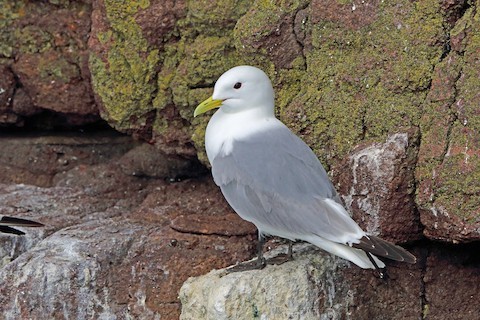Birdfinding.info ⇒ Locally common from April to August around its breeding colonies, many of which are in reasonably accessible locations in Alaska, eastern Canada, Iceland, the British Isles, and Norway, with a few more southerly in continental Europe: Denmark (Hirtshals and Bulbjerg), France (Cap Blanc Nez and Cap Fréhel), and Spain (Cabo Vilán). Seen commonly on pelagic trips in the North Pacific and North Atlantic. In Alaskan, Canadian, and western European waters it is common year-round. In Japanese and most U.S. waters—especially from California and New York south—it occurs mainly from October to April.
Black-legged Kittiwake
Rissa tridactyla
Breeds from arctic to cold temperate latitudes and winters in the North Atlantic and North Pacific Oceans.
Breeding. Breeds from April to August in large colonies on cliff ledges. In some parts of Europe, also nests on the ledges of buildings.
North Atlantic populations (tridactyla) breed from the Canadian Archipelago, both coasts of Greenland, Svalbard, Franz Josef Land, and Novaya Zemlya, south to the Gulf of St. Lawrence and northwestern Spain.
North Pacific populations (pollicaris) breed from the Arctic coast of eastern Siberia and northwestern Alaska south to the western coast of the Sea of Okhotsk, Sakhalin, the Kurile Islands, and south-coastal Alaska east to Glacier Bay.

Black-legged Kittiwake pair at nest. (Hornøya, Vardø, Finnmark, Norway; April 5, 2011.) © Christoph Moning
Nonbreeding. Disperses throughout cold areas of the North Pacific and North Atlantic from the edge of the sea-ice southward. Tends to remain some distance offshore, but often in near-coastal, continental shelf waters.
Winters south to southern Japan, southern Baja California, North Carolina, Azores, the Canary Islands, and the western Mediterranean.
Scattered individuals regularly wander south to Hong Kong, Taiwan, Hawaii, Nayarit, Florida, throughout the interiors of North America (especially around the Great Lakes) and Europe, and along coasts of the Gulf of Mexico, Yucatán Peninsula, Black Sea, and eastern Mediterranean.
Also somewhat regular as a fall and winter vagrant along northern coasts of the Arabian Sea from the U.A.E. to Karnataka. More exceptional vagrants have been recorded from the Gulf of Siam and the southern Caribbean, including Costa Rica, Panama, Venezuela, Barbados, and Trinidad.
Identification
A small gull with distinctive black wing-tips so crisply defined that they seem to have been dipped in ink. Other notable features are its unmarked straw-yellow bill and black feet.
Adults in breeding plumage have clean white heads, whereas in nonbreeding plumage they have variable, smudgy head markings dominated by a gray cowl on the hindcrown and nape, and a darker, blackish auricular spot.

Black-legged Kittiwake. (Bogoslova Island, Kamchatski Kraj, Russia; July 3, 2019.) © Peder Svingen

Black-legged Kittiwake. (Farne Islands National Nature Reserve, Northumberland, England; June 3, 2015.) © John Drummond

Black-legged Kittiwake. (Siglufjörður, Norðurland Eystra, Iceland; July 12, 2018.) © Braden Collard

Black-legged Kittiwake, showing ink-dipped wingtip pattern. (St. Paul Island, Alaska; June 12, 2012.) © Ryan O’Donnell
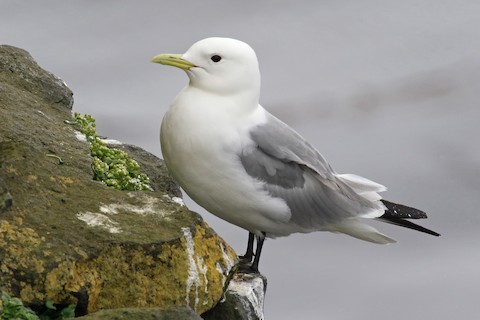
Black-legged Kittiwake. (St. Paul Island, Alaska; June 18, 2016.) © Phillip Edwards
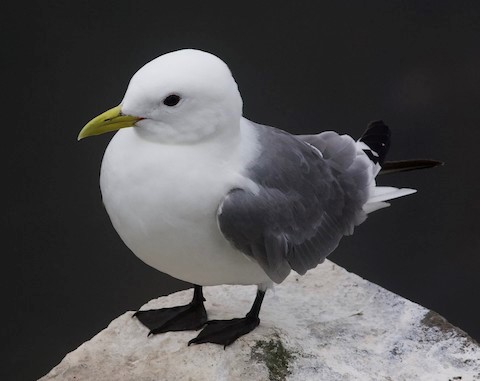
Black-legged Kittiwake. (Cape St. Mary’s Ecological Reserve, Newfoundland; July 16, 2019.) © Nick Lund
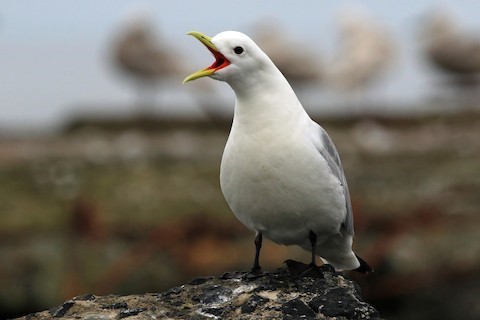
Black-legged Kittiwake. (St. Paul Island, Alaska; June 20, 2016.) © Phillip Edwards
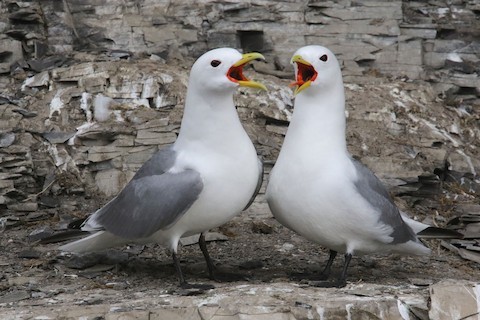
Black-legged Kittiwake. (Kapp Waldburg, Svalbard; June 29, 2018.) © Noah Strycker

Black-legged Kittiwake. (Cape St. Mary’s Ecological Reserve, Newfoundland; July 2, 2013.) © Dorian Anderson

Black-legged Kittiwake, nonbreeding plumage. (Half Moon Bay, California; February 13, 2021.) © Michael Hingerty
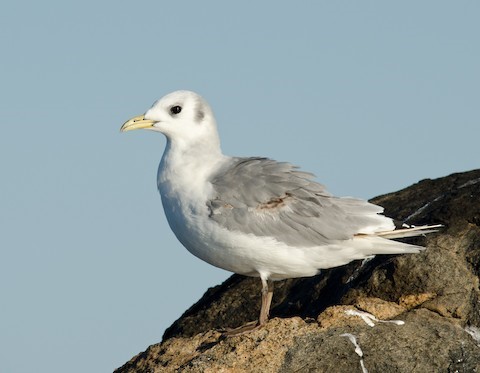
Black-legged Kittiwake, nonbreeding plumage. (Cape Sable Island, Nova Scotia; September 7, 2013.) © Alix d’Entremont
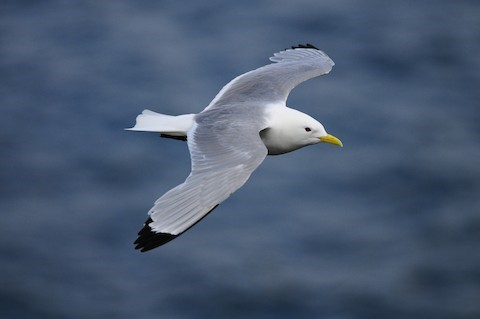
Black-legged Kittiwake. (Fowlsheugh RSPB Reserve, Scotland; June 24, 2011.) © Vincent Gaillard

Black-legged Kittiwake. (Flatrock Point, Newfoundland; June 4, 2017.) © Alvan Buckley

Black-legged Kittiwake. (St. Paul Island, Alaska; May 29, 2012.) © Ryan O’Donnell

Black-legged Kittiwake. (St. Paul Island, Alaska; May 24, 2015.) © Nigel Voaden

Black-legged Kittiwake. (St. Paul Island, Alaska; June 16, 2012.) © Ryan O’Donnell

Black-legged Kittiwake. (Handa Island, Scotland; June 22, 2016.) © Nigel Voaden
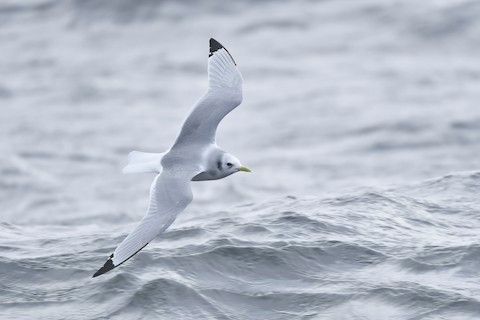
Black-legged Kittiwake, nonbreeding plumage. (Offshore from Bethany Beach, Delaware; February 1, 2020.) © Jonathan Irons
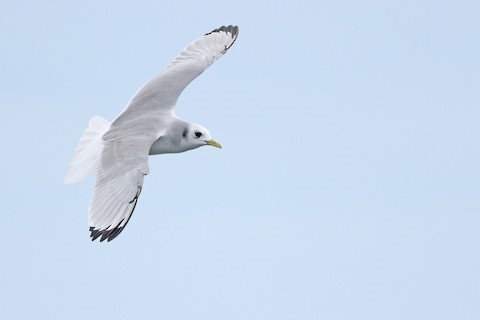
Black-legged Kittiwake, nonbreeding plumage. (Offshore from Chatham, Massachusetts; November 10, 2015.) © Evan Lipton
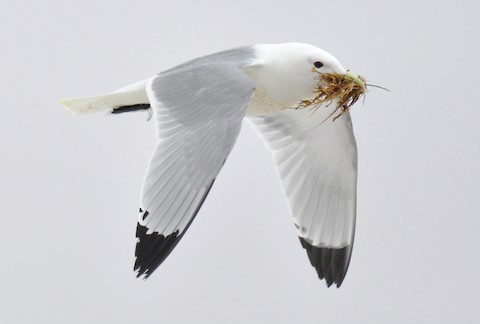
Black-legged Kittiwake. (St. Paul Island, Alaska; June 12, 2012.) © Ryan O’Donnell
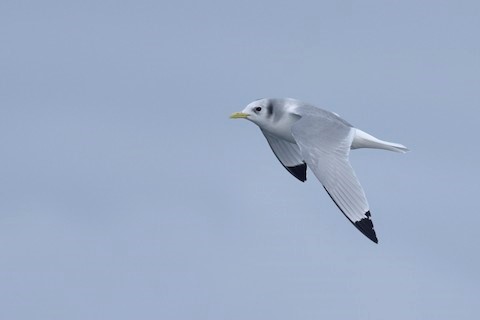
Black-legged Kittiwake, nonbreeding plumage. (Offshore from Bethany Beach, Delaware; February 1, 2020.) © Daniel Irons

Black-legged Kittiwake. (Forteau Bay, Labrador; August 5, 2017.) © John & Ivy Gibbons

Black-legged Kittiwake. (Mushamna, Svalbard; June 9, 2015.) © Christoph Moning
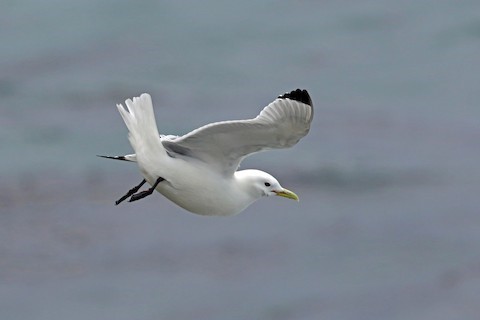
Black-legged Kittiwake. (St. Paul Island, Alaska; May 25, 2015.) © Nigel Voaden

Black-legged Kittiwake. (St. Paul Island, Alaska; May 29, 2012.) © Ryan O’Donnell

Black-legged Kittiwake, nonbreeding plumage. (Offshore from Ocean City, Maryland; February 1, 2020.) © Daniel Irons
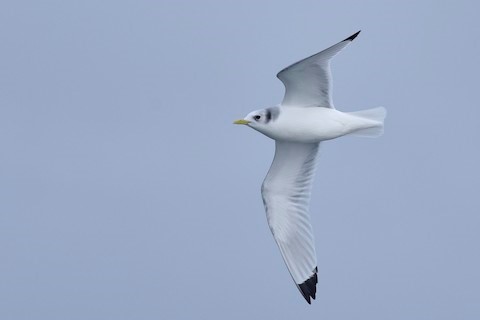
Black-legged Kittiwake, nonbreeding plumage. (Offshore from Bethany Beach, Delaware; February 1, 2020.) © Daniel Irons
Immature Plumages. Juveniles have black bills and extensive black markings on the upperparts.
The head has a gray shadow on the hindcrown, with a blacker auricular spot, and the back of the neck is predominantly black—a wide black half-collar. These markings sometimes appear as two black collars.
The wings have thick black bars on the secondary coverts and outer primaries, which contrast with a large white triangle on the trailing edge of the wing. In flight, these markings form a bold black “M” visible at long range.
The tail has a pronounced black terminal band.
During the first winter, the black markings on the head and wings lighten. First-summer subadult plumage resembles nonbreeding adult, often with traces of the juvenile markings.

Black-legged Kittiwake, immature. (Heimaey, Suðurland, Iceland; August 9, 2019.) © Caleb Putnam
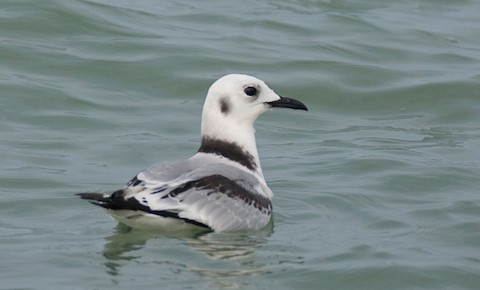
Black-legged Kittiwake, immature. (Hamilton, Ontario; September 7, 2009.) © Brandon Holden

Black-legged Kittiwake, immature. (Lake Havasu, California; January 20, 2019.) © Matthew Grube
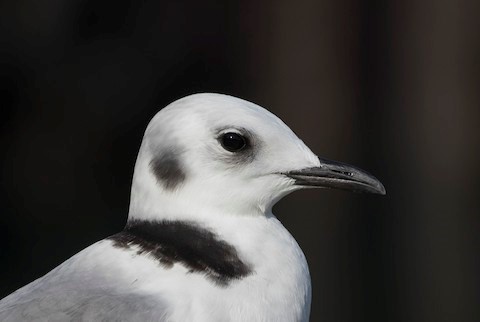
Black-legged Kittiwake, immature. (Heimaey, Suðurland, Iceland; August 9, 2019.) © Caleb Putnam

Black-legged Kittiwake. (Lake Macatawa, Michigan; January 4, 2018.) © Kevin Vande Vusse

Black-legged Kittiwake. (East of Chatham, Massachusetts; November 10, 2015.) © Evan Lipton
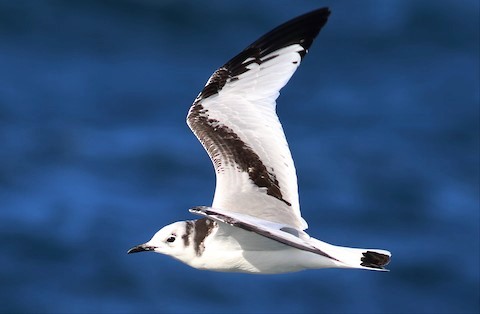
Black-legged Kittiwake. (Point Pinos, California; December 16, 2016.) © Paul Fenwick

Black-legged Kittiwake. (Lake Macatawa, Michigan; January 4, 2018.) © Kevin Vande Vusse
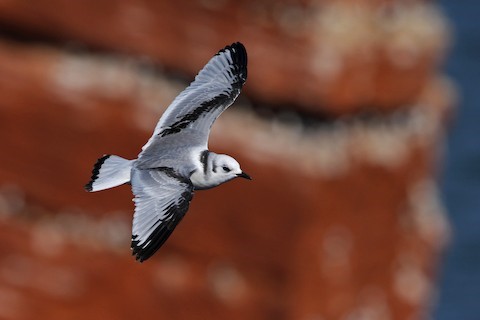
Black-legged Kittiwake. (Helgoland, Germany; August 3, 2009.) © Christoph Moning
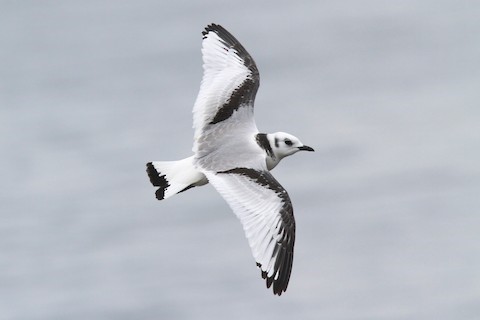
Black-legged Kittiwake, immature. (Ekkerøya, Finnmark, Norway; July 27, 2012.) © Volker Hesse

Black-legged Kittiwake. (Lake Macatawa, Michigan; January 4, 2018.) © Kevin Vande Vusse

Black-legged Kittiwake, immature. (St. Paul Island, Alaska; August 27, 2012.) © Ryan O’Donnell
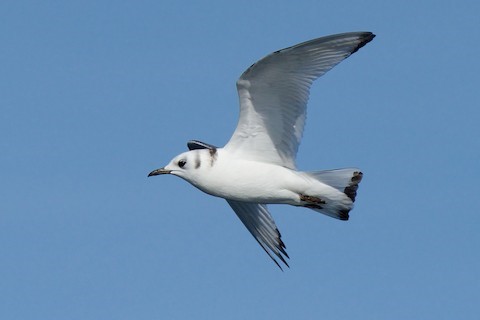
Black-legged Kittiwake, immature. (Offshore from Cape May, New Jersey; January 27, 2018.) © Marilyn Henry
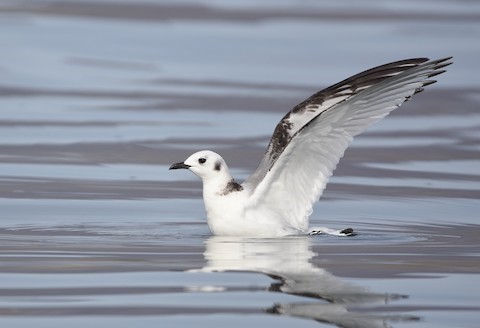
Black-legged Kittiwake, immature. (Lake Havasu State Park, Arizona; January 20, 2019.) © Christopher Lindsey
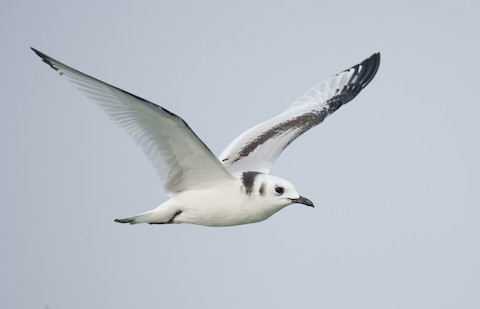
Black-legged Kittiwake, immature. (Hamilton, Ontario; September 7, 2009.) © Brandon Holden
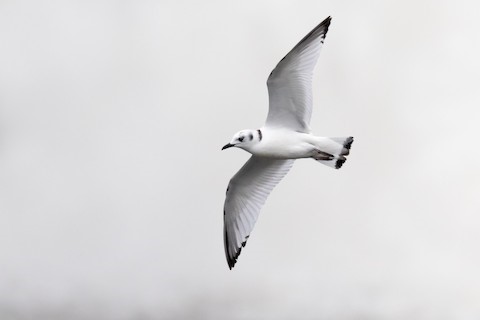
Black-legged Kittiwake, immature. (Hoover Reservoir, Westerville, Ohio; November 13, 2018.) © Brad Imhoff
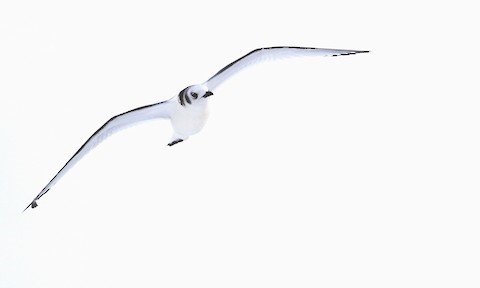
Black-legged Kittiwake, immature. (Lake Macatawa, Michigan; February 8, 2018.) © Aaron Boone

Black-legged Kittiwake, immature. (Lake Macatawa, Michigan; February 8, 2018.) © Aaron Boone
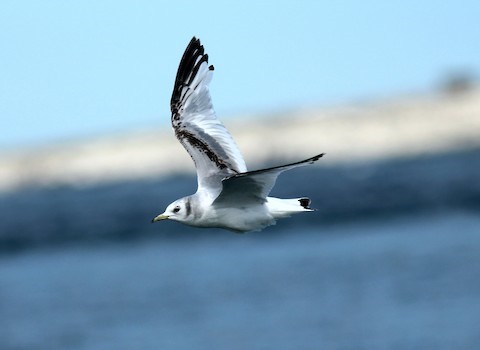
Black-legged Kittiwake, first-summer subadult with bill turning yellow. (Farne Islands National Nature Reserve, Northumberland, England; June 3, 2015.) © John Drummond

Black-legged Kittiwake, first-summer subadult with bill turning yellow. (Handa Island, Scotland; June 22, 2016.) © Nigel Voaden
Cf. Red-legged Kittiwake. Red-legged and Black-legged Kittiwakes are similar, closely related species, which occur together throughout Red-legged’s range. Adult leg color is the most obvious difference, but not always visible.
In flight, adult Red-legged can be distinguished at long range by its darker gray mantle and mostly gray undersides of the flight feathers—which are mostly white on Black-legged. Red-legged also has more extensive black on the leading edge of the primaries.
If only the head can be seen well, Red-legged can be distinguished by its much shorter bill and sometimes by the apparent size or shape of its head, which often appears disproportionately large, at least in comparison to its short bill.
Immature Red-legged differs from immature Black-legged in that it never shows a black tail tip and does not develop a full black “M” on the upperparts—on Red-legged, the black is always limited to the primaries. Note that juvenile Red-legged has black legs, so leg color becomes a reliable distinction during the first winter as Red-legged’s legs turn pale, then, pink, then red.

Black-legged Kittiwakes with two Red-legged in foreground and one in flight in the background—note Red-legged’s darker gray mantle and short bill. (St. Paul Island, Alaska; June 7, 2016.) © Lars Petersson
Cf. Immature Little Gull. Immature Black-legged Kittiwake and Little Gull can show approximately the same plumage pattern, with blackish head markings and a bold black “M” on the upperparts. The distribution of black on the upperparts differs, as Little has more extensively black upperwings with somewhat paler secondaries. At later stages where Little has a clearly defined “M” pattern, its neck is usually pale whereas the kittiwake retains a bold dark collar. The underwings also differ: the kittiwake’s are mostly white whereas Little’s are mostly dark-gray.
Cf. Immature Ross’s Gull. Immature Black-legged Kittiwake and Ross’s Gull can show approximately the same plumage pattern, with blackish head markings and a bold black “M” on the upperparts. Their head patterns usually differ, as the kittiwake has heavy black markings including a thick, smudgy blackish collar, which Ross’s lacks. Although the uppersides of their wings are similar, the undersides differ: the kittiwake’s are mostly white whereas Ross’s’ are generally dark-gray. Ross’s also differs in having a longer, wedge-shaped tail that has black tips mainly on the longer, central feathers, whereas the kittiwake has a square with an even-width, terminal black band.
Cf. Immature Sabine’s Gull. Immature Black-legged Kittiwake has a wide white triangle on the trailing edge of its upperwing, much like the white triangle on Sabine’s Gull’s upperwing. Unlike Sabine’s, the kittiwake plumages that have this triangle also have a bold black bar across the coverts.
Notes
Polytypic species consisting of two recognized subspecies.
References
Alderfer, J., and J.L. Dunn. 2014. National Geographic Complete Birds of North America (Second Edition). National Geographic Society, Washington, D.C.
BirdLife International. 2019. Rissa tridactyla (amended version of 2018 assessment). The IUCN Red List of Threatened Species 2019: e.T22694497A155617539. https://dx.doi.org/10.2305/IUCN.UK.2018-2.RLTS.T22694497A155617539.en. (Accessed February 15, 2021.)
Brazil, M. 2009. Birds of East Asia. Princeton University Press.
eBird. 2021. eBird: An online database of bird distribution and abundance. Cornell Lab of Ornithology, Ithaca, N.Y. http://www.ebird.org. (Accessed February 15, 2021.)
Garcia-del-Rey, E. 2011. Field Guide to the Birds of Macaronesia: Azores, Madeira, Canary Islands, Cape Verde. Lynx Editions, Barcelona.
Harrison, P. 1983. Seabirds: An Identification Guide. Houghton Mifflin, Boston.
Howell, S.N.G., and J.L. Dunn. 2007. Gulls of the Americas. Houghton Mifflin, Boston.
Howell, S.N.G., and S. Webb. 1995. A Guide to the Birds of Mexico and Northern Central America. Oxford University Press.
Kirwan, G.M., A. Levesque, M. Oberle, and C.J. Sharpe. 2019. Birds of the West Indies. Lynx Edicions, Barcelona.
Mullarney, K., L. Svensson, D. Zetterström, and P.J. Grant. 1999. Birds of Europe. Princeton University Press.
Pyle, R.L., and P. Pyle. 2017. The Birds of the Hawaiian Islands: Occurrence, History, Distribution, and Status. Version 2 (January 1, 2017). http://hbs.bishopmuseum.org/birds/rlp-monograph/. B.P. Bishop Museum, Honolulu, Hawaii.
Sibley, D.A. 2000. The Sibley Guide to Birds. Alfred A. Knopf. New York.
van Perlo, B. 2002. Birds of Western and Central Africa. Princeton University Press.
Xeno-Canto. 2021. Black-legged Kittiwake – Rissa tridactyla. https://www.xeno-canto.org/species/Rissa-tridactyla. (Accessed February 15, 2021.)

